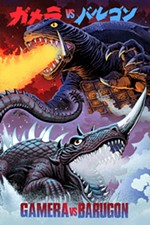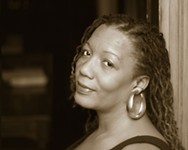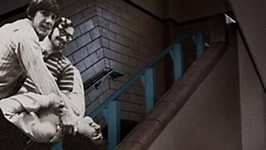Citizen Science
The enlightenment of Jeanne Liotta
By Sarah Smith, Fri., Feb. 17, 2012
Karaoke mavens know well the incredible strangeness of the videos that accompany their song selections in Korean karaoke joints. A shot of swans on a sun-dappled lake might be followed by a shot of a praying mantis riding a bicycle on a miniature high wire or a leather-clad couple chasing each other on motorcycles through Seoul. The format of scrolling lyrics at the bottom of the screen accompanied by such sweet, mad juxtapositions has caught the eye of plenty of indie filmmakers – Christeene's recent PJ Raval-directed music video for "Workin' on Grandma," in all its overacted, Vaseline-lensed glory, provides a particularly delightful local example – but Jeanne Liotta's take on the subgenre is especially telling. The New York- and Denver-based artist's 2009 film "Sweet Dreams" notes that it was "shot on location in Second Life," the virtual-reality platform in which users create avatars corresponding to their every wish, no matter how impossible or fanciful. It's a world where you can be a breakdancing hermaphroditic wolf if you want, a kind of wish fulfillment not so different, say, from the desire to outdo Tom Jones or Michael Bolton in a dark, smoky room.
Commissioned by the now-defunct Portland, Ore., film festival PDX, the piece provided Liotta a guilt-free reason to explore Second Life. "What really struck me about [Second Life] is that everything's a construction," she says. "We construct our performance of ourselves on a daily basis, but we don't always think of it like that. But in Second Life, I've been afforded the opportunity to meditate on that all the time. ... Not to get too intellectual about the Eurhythmics, but it's a song about fantasy, right? This search and long view – and one of the beautiful things in Second Life is that you can fly. Doesn't everybody want to fly? I don't know if you can call it an erotic experience, but it was close to being an erotic experience, this very palpable, sensory body experience even though it's an avatar on a screen and you're hitting the 'fly' button – it's an extension of yourself. And I feel like I soared. ... It's like this virtual dreamspace: a little science fiction, a little bit sexy just because it feels so limitless."
Liotta's work follows her enthusiasms, whether the result is a series of short films titled "Science's Ten Most Beautiful Experiments," a collaged video of nighttime sky footage (2007's "Observando el Cielo"), or Kodachrome footage of a lunar eclipse (2005's "Eclipse," an inclusion in the Whitney Biennial). She notes that science and astronomy have sparked much of her work over the last 10 years, but a casual glance at her filmography reveals a zeal for teasing out vast ideas from anything that catches her eye, always taking pains to approach the materials, whether they be archival footage or a poem, with care. She says, "I think about how much to touch something or how little to touch it. All the time. How much do you intervene with something that already exists? ... That just became really heavy, I realize, for a Saturday morning! This is something I think about a lot, and in editing, you're completely manipulating relationships, so it's a big responsibility. Sometimes when I work with not just poetry but let's say, found images, archival images, I think about that same level of, ethics is maybe the way to talk about it. It had its own life before I ever saw it, so let me try to meet it somewhere and not handle it too much."
Respect for one's materials is one of those bromides artists toss off frequently, but the effect of Liotta's ethics rings clearly, especially in her collaborations. "Dark Enough," a 2011 film made with poet Lisa Gill, pulls off an integration of text and image rare in such collaborations. Instead of adding the text in postproduction, a technique common in film-poetry collaborations, Liotta manipulated the words, treating them as another layer in the flickering, black-and-white fuzz of the film: "I was a little nervous about these words from someone else that I was going to have my way with. So we did correspond, but I started my working method – I have a title board, like an actual sign board with letters that you put in, and I actually reconstructed all of the poems from the book that I like. I did the stanzas on the title board and made rubbings, like graphite and paper. It was really interesting for me to actually reconstruct the words and handle the letters and think about the language as a material – we say that all the time; I hear poets talk about that all the time, but I was literally making it into a mechanical term! I had rubbings and I had paper with text on it, and I refilmed that. I felt like I needed to start with the material aspect and then slowly find a way to bring it into the moving image." The result is an ephemeral texture with a little frisson of personal warmth – the time-consuming process is somehow palpable in the finished piece.
Mounting a career retrospective, as Liotta recently has, makes a great opportunity to highlight the through lines in an artist's body of work. While science has a central place in Liotta's constellation of interests, it's clear that an enthusiasm for the underlying work of scientific thought is the real spark: "Working with film has something of a scientific base in and of itself – you have that chemical aspect, you've got the optical aspect, so you're really dealing with perception, ultimately, which I could call science, in a way; it's some science and philosophy. I use the term 'natural philosophy' a lot because that's what we used to call it before we had this term 'science.' It was everyone's job – it was like citizen science. Each person has the responsibility or the opportunity as a human being to discover what their world is made of and what they think about it, to observe and take notes and reflect upon – that's our job as human beings somehow, that's what I feel like I'm doing when I make things. It's just my thinking."
Having taken a circuitous path to art – studying theatre at NYU, playing in a band, and falling in with the kind of bohemian types known so well to Austin – shows in Liotta's conversational arabesques, in which possibility caroms about so infectiously it's difficult not to drop the phone and get to work on a project. "I like to go back to the ancients all the time, myself," she says. "I use quotations from Lucretius, who's one of my main guys. But I feel like part of the reason to do that is to kind of remember that there were other trajectories of thought and knowledge that could've taken place, but we had to get to the Enlightenment. ... Not that I'm against the Enlightenment! But things get lost along the way. It's true in every type of art and science form. Certain kinds of advancements get made – in film, we always say, 'Oh, once they had the synced sound down and we went down the road of the talkies, so much was lost, and what would cinema have developed into otherwise?'"
This notion provides a handy field guide for Liotta's own work: What would an eclipse look like if light couldn't bend? What would an aria transforming into a woman look like? If there's any luck, one of those divergent realities must house a karaoke bar where Liotta's "Sweet Dreams" is cued up and waiting for an intrepid singer. "One time I was in Pompeii and I was following along with a tour guide and talking about the pre-Renaissance mosaics, and he was saying, 'Yes, the Renaissance came along and then all of a sudden everything was about perspective.' We have this idea that perspective was reality, and we left behind – these mosaics just stopped there. What could have happened if that hadn't developed? And I thought, 'Oh my god – I had never thought of it.'"
Jeanne Liotta screens various works in 16mm film and digital video Friday, Feb. 24, 7pm at AMOA-Arthouse at the Jones Center (700 Congress). Event co-presented by Experimental Response Cinema.













